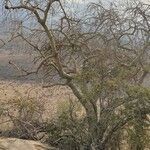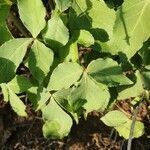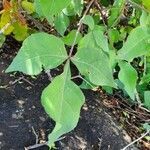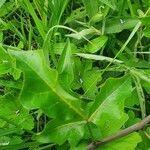Tree 6–20 m. tall, the trunk often up to 5 m. tall below the lowest branch and 35 cm. diameter at breast height; outer bark peeling in large white or yellowish flakes from the blue-green under-bark; slash with red layers; exudate yellowish, very slightly scented; young twigs straight, or very slightly zigzag, fluted, glabrous or sparsely pubescent, green at first, later grey, ± 2 mm. in diameter.. Leaves 3–5-foliolate, almost glabrous or pubescent with ± erect 0.1–0.5 mm. long hairs; rhachis up to 10 cm. including a petiole up to 7 cm. long; leaflets thin, their margins serrate or crenate almost throughout their length with 12–22 teeth on each side, the laterals cuneate-obovate or elliptic-obovate, sessile, rounded at the base, rounded or acute apically, up to 6 cm. long and 4 cm. wide, the terminal obovate attenuate basally into a pseudo-petiolule (? rhachis extension) which may be up to 17 mm. long, up to 9 cm. long and 6 cm. wide.. Prophylls ± 9 mm. long and 3 mm. wide.. Inflorescences pubescent or less often glabrescent, pedunculate cymes appearing with the leaves, the ♂ 5–25-flowered on peduncles 25–50 mm. long with very caducous linear bracts ± 3 mm. and pedicels up to 10 mm. long, but usually much less; ♀ 1–5-flowered on peduncles up to 30 but usually ± 5 mm. long and pedicels up to 10 but usually ± 3 mm. long.. Receptacle of ♂ flowers sparsely pubescent, 1 mm. deep.. Calyx-lobes triangular, pubescent, 1.6 mm. long.. Petals oblong, 3 mm. long, 2 mm. wide, sparsely silky outside.. Filaments 1.6 and 1.0, anthers 0.6 and 0.5 mm. long.. Fruits usually single on a 10–15 mm. stalk, of which 2/3 is peduncle, sometimes 2 or 3 together on a common peduncle.. Drupe almost glabrous or sparsely pubescent, flattened-ellipsoid, ± 13 × 12 × (5 + 6) mm.; pericarp 2–3 mm. thick; pseudaril with 2 thick triangular facial lobes which nearly reach the tip of the stone and no sutural lobes; stone smooth, gently convex on both sides, ± 8 × 7.5 × (2 + 3) mm.. Fig. 14/9–13.
More
A tree. It grows 6-20 m tall. The trunk has the lowest branches above 5 m. The trunk is 35 cm across. The bark peels in large white flakes. The leaves have 3-5 leaflets. The leaflets are narrow and they have teeth along the edge. The leaflets are 6 cm long by 4 cm wide. The fruit are 13 mm long by 5 mm wide and flattened.




